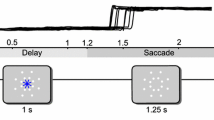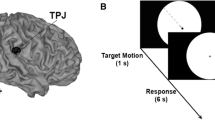Abstract
Transcranial magnetic stimulation (TMS) is a popular technique that can be used to investigate the functional role of specific cortical areas with reference to a particular behavioural task. Single-cell recording studies performed in non-human primates have demonstrated that a region of the parietal lobe known as the lateral intraparietal area is specialized in the planning and control of saccadic eye movements. The homologue of this area in humans is termed the parietal eye fields (PEF) and its role in relation to saccades has previously been examined using TMS. In this paper individual variability in the functional effect of parietal TMS on the latency, amplitude and angular direction of visually-guided saccades has been assessed. By examining individual variability in the spatial distribution of scalp-based localization and brain surface anatomy and stereotaxic localizations of the PEF it was shown that the distances between the sites determined by these three methods were not negligible, which raises problems regarding the most reliable anatomical localization technique to use. An assessment of the effect of TMS on saccade metrics (latency, amplitude error and angular error) at a grid of locations over parietal cortex demonstrated a large amount of intra-individual variability in the site where TMS had most affected saccades, leading to the conclusion that there is individual variability in the functional effects of parietal TMS on saccade planning and execution. This study confirms the idea that it may be problematic to use a fixed scalp location for every participant in a study. It may in fact be more appropriate to determine TMS sites functionally on an individual basis if possible. This finding may guide further studies using TMS and saccade planning in order to optimize their capability to investigate this area and to draw meaningful biological conclusions.



Similar content being viewed by others
References
Andersen RA, Gnadt JW (1989) Posterior parietal cortex. Rev Oculomot Res 3:315–335
Andersen RA, Brotchie PR, Mazzoni P (1992) Evidence for the lateral intraparietal area as the parietal eye field. Curr Opin Neurobiol 2:840–846
Andersen RA, Snyder LH, Bradley DC, Xing J (1997) Multimodal representation of space in the posterior parietal cortex and its use in planning movements. Annu Rev Neurosci 20:303–330
Ashbridge E, Walsh V, Cowey A (1997) Temporal aspects of visual search studied by transcranial magnetic stimulation. Neuropsychologia 35:1121–1131
Bestmann S, Baudewig J, Siebner HR, Rothwell JC, Frahm J (2004) Functional MRI of the immediate impact of transcranial magnetic stimulation on cortical and subcortical motor circuits. Eur J Neurosci 19:1950–1962
Brainard DH (1997) The psychophysics toolbox. Spat Vis 10:433–436
Brasil-Neto JP, McShane LM, Fuhr P, Hallett M, Cohen LG (1992) Topographic mapping of the human motor cortex with magnetic stimulation: factors affecting accuracy and reproducibility. Electroencephalogr Clin Neurophysiol 85:9–16
Colby CL, Duhamel JR (1996) Spatial representations for action in parietal cortex. Brain Res Cogn Brain Res 5:105–115
Colby CL, Goldberg ME (1999) Space and attention in parietal cortex. Annu Rev Neurosci 22:319–349
Couturier JL (2005) Efficacy of rapid-rate repetitive transcranial magnetic stimulation in the treatment of depression: a systematic review and meta-analysis. J Psychiatry Neurosci 30:83–90
van Donkelaar P, Muri R (2002) Craniotopic updating of visual space across saccades in the human posterior parietal cortex. Proc Biol Sci 269:735–739
Duhamel JR, Colby CL, Goldberg ME (1992) The updating of the representation of visual space in parietal cortex by intended eye movements. Science 255:90–92
Elkington PT, Kerr GK, Stein JS (1992) The effect of electromagnetic stimulation of the posterior parietal cortex on eye movements. Eye 6(Pt 5):510–514
Gray H (1918) Anatomy of the human body. Bartleby.com. Retrieved 21.09.05 from http://www.bartleby.com/107/illus517.html
Heide W, Binkofski F, Seitz RJ, Posse S, Nitschke MF, Freund HJ, Kompf D (2001) Activation of frontoparietal cortices during memorized triple-step sequences of saccadic eye movements: an fMRI study. Eur J Neurosci 13:1177–1189
Jackson SR (2001) ȁ8Action bindingȁ9: dynamic interactions between vision and touch. Trends Cogn Sci 5:505–506
Kammer T, Beck S, Thielscher A, Laubis-Herrmann U, Topka H (2001) Motor thresholds in humans: a transcranial magnetic stimulation study comparing different pulse waveforms, current directions and stimulator types. Clin Neurophysiol 112:250–258
Kapoula Z, Isotalo E, Muri RM, Bucci MP, Rivaud-Pechoux S (2001) Effects of transcranial magnetic stimulation of the posterior parietal cortex on saccades and vergence. Neuroreport 12:4041–4046
Konen CS, Kleiser R, Wittsack HJ, Bremmer F, Seitz RJ (2004) The encoding of saccadic eye movements within human posterior parietal cortex. Neuroimage 22:304–314
Li CS, Mazzoni P, Andersen RA (1999) Effect of reversible inactivation of macaque lateral intraparietal area on visual and memory saccades. J Neurophysiol 81:1827–1838
Luna B, Thulborn KR, Strojwas MH, McCurtain BJ, Berman RA, Genovese CR, Sweeney JA (1998) Dorsal cortical regions subserving visually guided saccades in humans: an fMRI study. Cereb Cortex 8:40–47
Medendorp WP, Goltz HC, Vilis T, Crawford JD (2003) Gaze-centered updating of visual space in human parietal cortex. J Neurosci 23:6209–6214
Merriam EP, Genovese CR, Colby CL (2003) Spatial updating in human parietal cortex. Neuron 39:361–373
Mort DJ, Perry RJ, Mannan SK, Hodgson TL, Anderson E, Quest R, McRobbie D, McBride A, Husain M, Kennard C (2003) Differential cortical activation during voluntary and reflexive saccades in man. Neuroimage 18:231–246
Muri RM, Vermersch AI, Rivaud S, Gaymard B, Pierrot-Deseilligny C (1996) Effects of single-pulse transcranial magnetic stimulation over the prefrontal and posterior parietal cortices during memory-guided saccades in humans. J Neurophysiol 76:2102–2106
Muri RM, Gaymard B, Rivaud S, Vermersch A, Hess CW, Pierrot-Deseilligny C (2000) Hemispheric asymmetry in cortical control of memory-guided saccades. A transcranial magnetic stimulation study. Neuropsychologia 38:1105–1111
Oyachi H, Ohtsuka K (1995) Transcranial magnetic stimulation of the posterior parietal cortex degrades accuracy of memory-guided saccades in humans. Invest Ophthalmol Vis Sci 36:1441–1449
Pascual-Leone A, Bartres-Faz D, Keenan JP (1999) Transcranial magnetic stimulation: studying the brain–behaviour relationship by induction of ȁ8virtual lesionsȁ9. Philos Trans R Soc Lond B Biol Sci 354:1229–1238
Pelli DG (1997) The VideoToolbox software for visual psychophysics: transforming numbers into movies. Spat Vis 10:437–442
Posner MI, Walker JA, Friedrich FJ, Rafal RD (1984) Effects of parietal injury on covert orienting of attention. J Neurosci 4:1863–1874
Rizzolatti G, Fogassi L, Gallese V (1997) Parietal cortex: from sight to action. Curr Opin Neurobiol 7:562–567
Ross J, Morrone MC, Goldberg ME, Burr DC (2001) Changes in visual perception at the time of saccades. Trends Neurosci 24:113–121
Sereno MI, Pitzalis S, Martinez A (2001) Mapping of contralateral space in retinotopic coordinates by a parietal cortical area in humans. Science 294:1350–1354
Snyder LH, Batista AP, Andersen RA (1997) Coding of intention in the posterior parietal cortex. Nature 386:167–170
Terao Y, Fukuda H, Ugawa Y, Hikosaka O, Hanajima R, Furubayashi T, Sakai K, Miyauchi S, Sasaki Y, Kanazawa I (1998) Visualization of the information flow through human oculomotor cortical regions by transcranial magnetic stimulation. J Neurophysiol 80:936–946
Yang Q, Kapoula Z (2004) TMS over the left posterior parietal cortex prolongs latency of contralateral saccades and convergence. Invest Ophthalmol Vis Sci 45:2231–2239
Author information
Authors and Affiliations
Corresponding author
Rights and permissions
About this article
Cite this article
Ryan, S., Bonilha, L. & Jackson, S.R. Individual variation in the location of the parietal eye fields: a TMS study. Exp Brain Res 173, 389–394 (2006). https://doi.org/10.1007/s00221-006-0379-9
Received:
Accepted:
Published:
Issue Date:
DOI: https://doi.org/10.1007/s00221-006-0379-9




